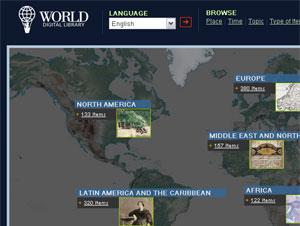The World Digital Library
The World Digital Library aims to gather great things from everywhere, and then make them accessible to everyone with an internet connection. The site lets you flip through notable and ancient artifacts from around the globe – books, documents, maps and pictures, mostly.
The World Digital Library is a project of UNESCO, the cultural arm of the United Nations. It works thanks to collaboration among international libraries and institutions, all of which are making treasures available online.
"Moving forward there are two main challenges. One is to add many more partners, 30 is a good number, when you think there are more than 190 countries in the world; we have a long way to go. So we have to add more partners and we have to add more content, more books, more manuscripts, more maps," says the Library’s director, John Van Oudenaren.
The lead partner at the moment is The Library of Congress. It’s made over 500 items accessible through the site. The National Library of Serbia has 35 up online so far, including Miroslav’s Gospel, a beautiful manuscript book created around the year 1180 by two student monks.
If you want to know more, then you can watch a local curator talking about it. There’s an English explanation too. In fact, the accompanying text can be read in each of the official languages of the United Nations.
Sreten Ugricic directs the Serbian National Library – he’s also the curator we just heard in the last clip. Ugricic says the new library will bring together people from different places by collecting the best things from those places. "Our criteria are the synthesis of diversity of cultures or nations and universality of values of their heritage."
Some other things you’ll find in the World Digital Library: An eleventh-century Japanese novel; the first map ever to mention America; and various issues of Layla, the first women’s magazine to be published in Iraq. It was launched in 1923 and published under the banner, "On the Way to Revival of the Iraqi Woman."
You can also find some audio clips in the library. One example is an early recording of the Marseillaise, the French national anthem. It was made around 1899 using a recording device called the "napkin ring", a conical cylinder of celluloid mounted on a brass frame. And the World Digital Library tells me that smaller napkin rings were used to make talking dolls.
PRI’s "The World" is a one-hour, weekday radio news magazine offering a mix of news, features, interviews, and music from around the globe. "The World" is a co-production of the BBC World Service, PRI and WGBH Boston.
